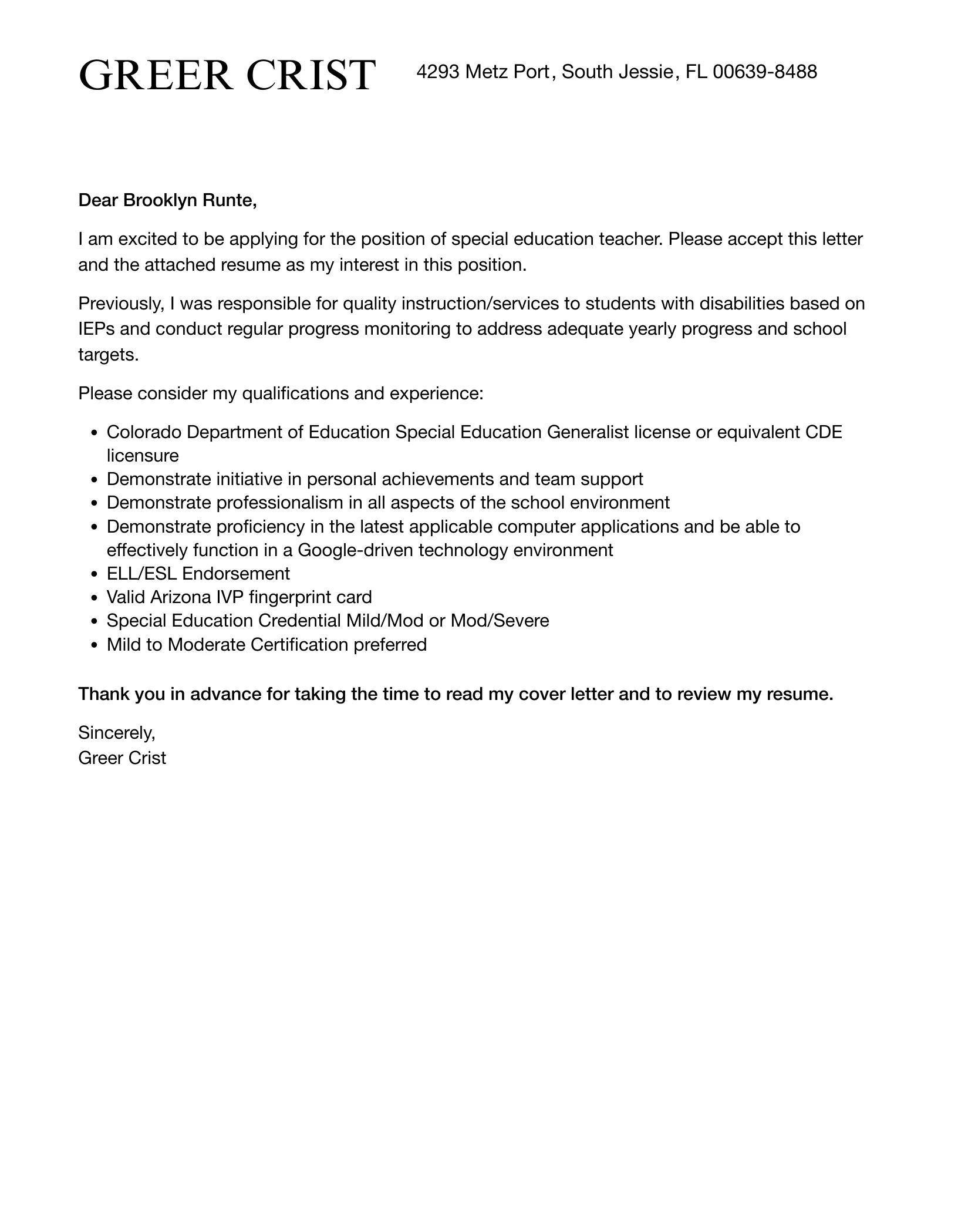Why You Need a Great Cover Letter for Special Education Aide
A cover letter is your first opportunity to make a positive impression on a potential employer. For a Special Education Aide position, a well-crafted cover letter is crucial because it allows you to showcase your passion for supporting students with special needs, highlight relevant skills, and demonstrate why you’re the best fit for the role. It goes beyond the resume, allowing you to explain your experiences in detail and connect them to the specific requirements of the job. In a competitive job market, a compelling cover letter can be the deciding factor in securing an interview, setting you apart from other applicants. A strong cover letter reveals your understanding of the needs of students with disabilities and highlights your commitment to their success. It is your chance to tell your story, demonstrating your understanding of the role and your genuine enthusiasm for working with children who require additional support.
Highlighting Your Skills and Experience
Your cover letter is the perfect place to highlight the skills and experience that make you an ideal Special Education Aide. This includes not only what you’ve done but also how you’ve done it, focusing on the impact of your actions. Be specific and provide concrete examples of your achievements and responsibilities. Focus on the aspects of your experience that directly relate to the job description, emphasizing your ability to support students’ academic, social, and emotional development. When describing your experience, use action verbs and quantify your accomplishments whenever possible. For example, instead of saying ‘Assisted students with their assignments,’ you could say ‘Provided individualized support to 15 students, resulting in a 20% improvement in their assignment completion rates.’ This specificity demonstrates the value you bring and how your skills can benefit the students and the school.
Classroom Management and Organization Skills
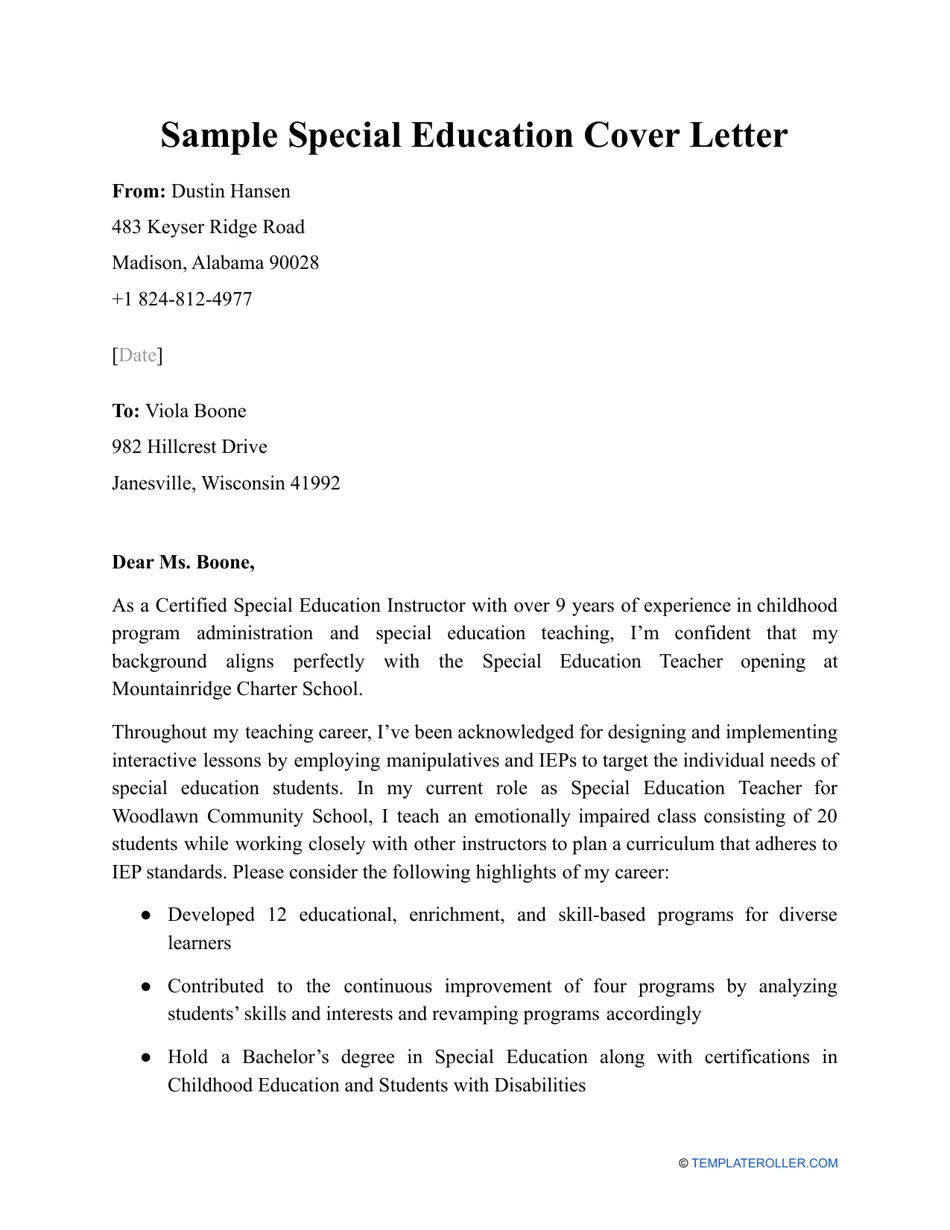
Classroom management and organization are essential for a Special Education Aide. Detail your experience in maintaining a structured and supportive learning environment. Highlight your ability to assist in organizing materials, preparing lesson aids, and implementing behavior management strategies. Mention any experience you have with creating visual schedules, adapting activities, or using assistive technology. Illustrate your organizational skills by describing how you managed student records, tracked progress, or created systems to support student learning. Emphasize your proficiency in creating a calm and productive classroom atmosphere where students feel safe, supported, and ready to learn. Demonstrating these skills shows your ability to contribute to an effective and well-managed classroom that promotes student success and well-being.
Experience with Students with Special Needs
Experience with students with special needs is a cornerstone of a successful application. In your cover letter, clearly state the types of disabilities you have worked with and the specific strategies you have employed. Describe your understanding of Individualized Education Programs (IEPs) and how you have assisted in implementing them. Detail your experience with modifying lesson plans, providing one-on-one support, and adapting materials to meet individual student needs. Highlight any training or certifications you have in areas such as autism spectrum disorder, learning disabilities, or behavioral interventions. Showcasing your direct experience with students, along with the positive impact you have made in their lives, will strongly position you as a qualified candidate who is passionate about making a difference.
Adaptability and Patience
Adaptability and patience are paramount in special education. Illustrate instances where you demonstrated flexibility in adjusting to changing situations and student needs. Share examples of how you have remained patient and supportive when facing challenges. Describe your ability to work with diverse learning styles, adapt to unexpected events, and maintain a positive attitude. Highlight your ability to remain calm under pressure, as well as your willingness to learn new strategies and approaches. Emphasizing your adaptability and patience will convey your understanding of the demanding nature of the role and reassure employers that you can effectively support students and contribute to a positive learning environment.
Formatting Your Special Education Aide Cover Letter
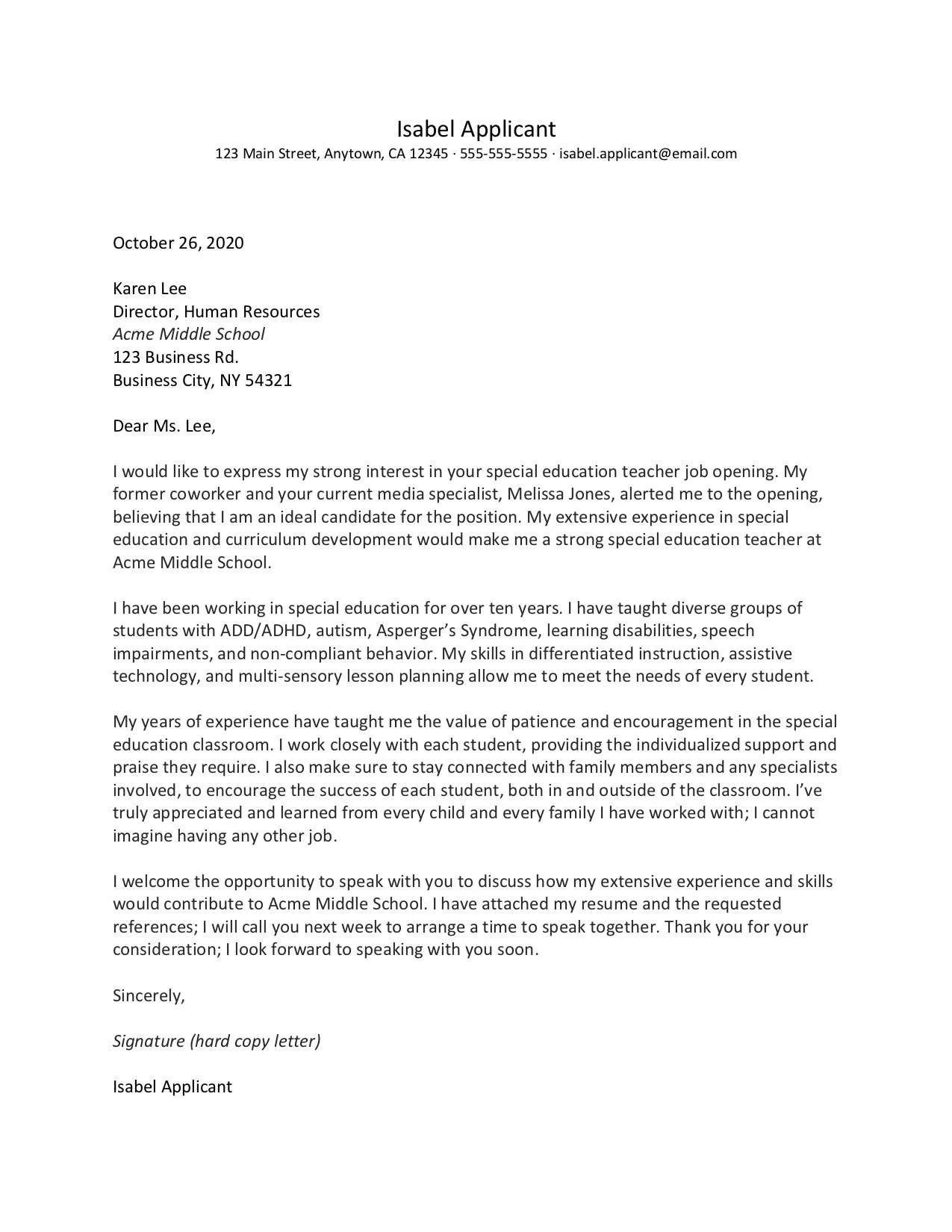
The format of your cover letter is just as important as the content. A well-formatted letter is easy to read and professional in appearance, reflecting your attention to detail. Use a standard business letter format with clear headings, concise paragraphs, and proper spacing. Choose a readable font like Times New Roman, Arial, or Calibri, and maintain a consistent font size throughout the document. Make sure your letter is free of grammatical errors and typos, as this can create a negative impression. Aim for a one-page letter, keeping it focused and to the point. This demonstrates respect for the hiring manager’s time and increases the likelihood that they will read your entire letter. Proper formatting sets a tone of professionalism and shows that you take your application seriously.
Contact Information and Date
Begin your cover letter by including your contact information, such as your name, address, phone number, and email address, at the top left corner. Directly below this, include the date of the letter. This information ensures that the hiring manager can easily contact you. Ensure your email address is professional and appropriate, avoiding nicknames or unprofessional language. If you are applying for a specific position, include the date and the name of the hiring manager, if known, along with the school or district’s address. This attention to detail demonstrates your commitment to the application process and ensures the letter is properly directed. It shows your respect for the organization and your understanding of professional communication standards.
Professional Salutation
The salutation sets the tone for your letter, so make sure it is professional and appropriate. If you know the hiring manager’s name, use it: ‘Dear Mr./Ms./Mx. [Last Name].’ If you don’t know the hiring manager’s name, use a general salutation like ‘Dear Hiring Manager’ or ‘Dear [School Name] Hiring Committee.’ Avoid overly casual salutations like ‘Hi’ or ‘Hello.’ Using a personalized salutation shows that you have taken the time to research the organization and shows respect. Always spell the name correctly and double-check your spelling. The salutation is the first point of direct contact, and a professional approach immediately conveys your seriousness about the position and your commitment to the school.
Opening Paragraph
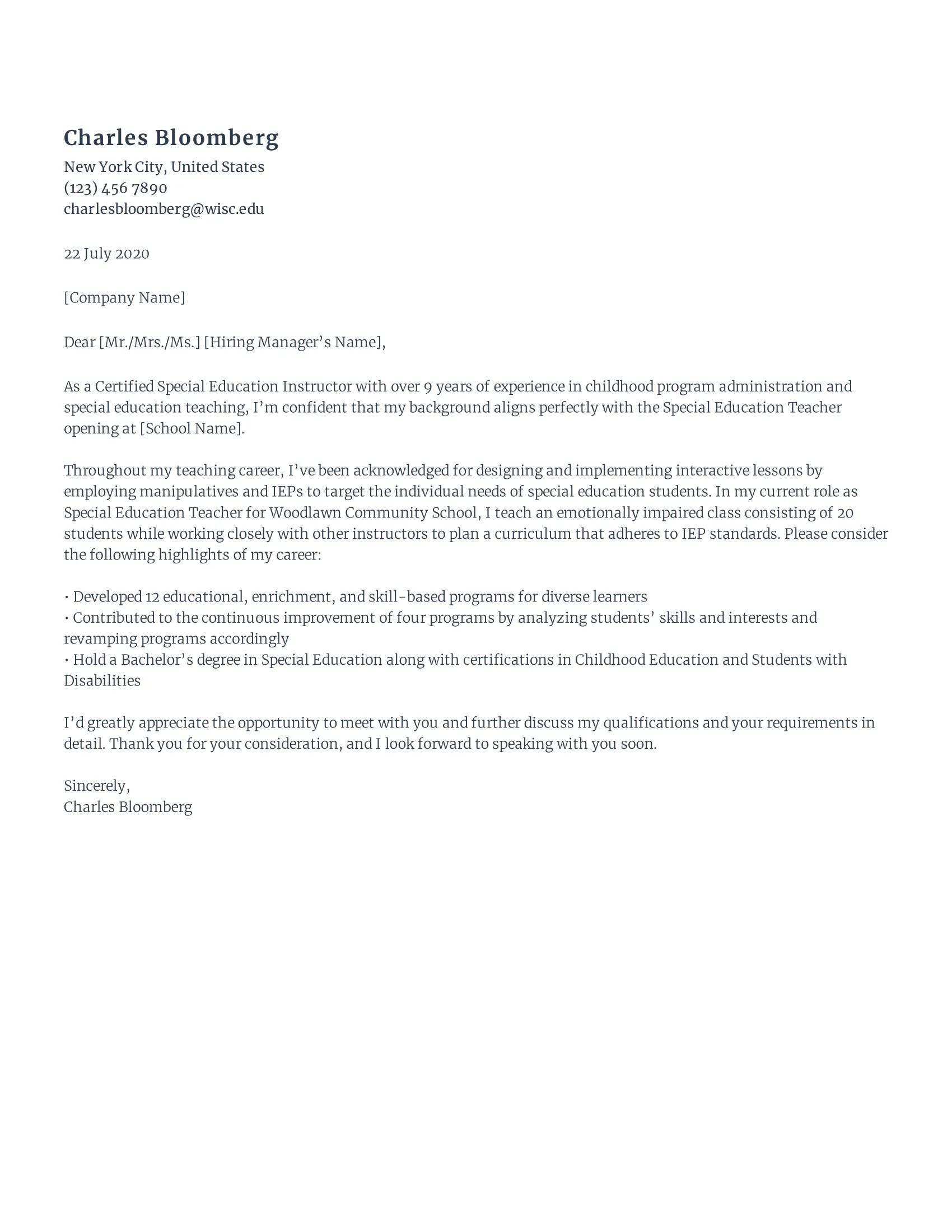
The opening paragraph should immediately grab the reader’s attention and state the purpose of your letter. Briefly mention the position you are applying for and where you saw the job posting. State your enthusiasm for the opportunity and express your interest in working as a Special Education Aide. Include a brief statement about your key qualifications or the unique value you bring to the role. The opening paragraph should be concise and engaging, setting the stage for the rest of the letter. Make sure the opening directly addresses the job requirements. This sets the stage for the rest of your letter, inviting the reader to learn more about your qualifications and experiences.
Body Paragraphs
The body paragraphs are where you elaborate on your skills and experience. Structure your paragraphs logically, using the job description as a guide. Address the key requirements and demonstrate how your qualifications match the needs of the position. Provide specific examples of your experience, using action verbs to describe your accomplishments and responsibilities. Include quantifiable results whenever possible, such as ‘increased student engagement by 20%’ or ‘assisted in implementing IEP goals for 10 students.’ Break down your skills and experiences into different paragraphs, highlighting different aspects to showcase your expertise. Keep each paragraph focused and relevant, avoiding unnecessary information. This section is your opportunity to show why you are the ideal candidate and demonstrate how you can contribute to student success.
Closing Paragraph
Your closing paragraph should reiterate your interest in the position and summarize your key qualifications. Thank the hiring manager for their time and consideration. Include a call to action, such as expressing your availability for an interview and providing your contact information. Maintain a confident and enthusiastic tone, expressing your eagerness to discuss your qualifications further. The closing paragraph is your final opportunity to make a positive impression and emphasize your readiness to take the next step in the hiring process. A strong closing leaves the reader with a clear understanding of your interest and the actions you expect to take.
Proofreading and Editing
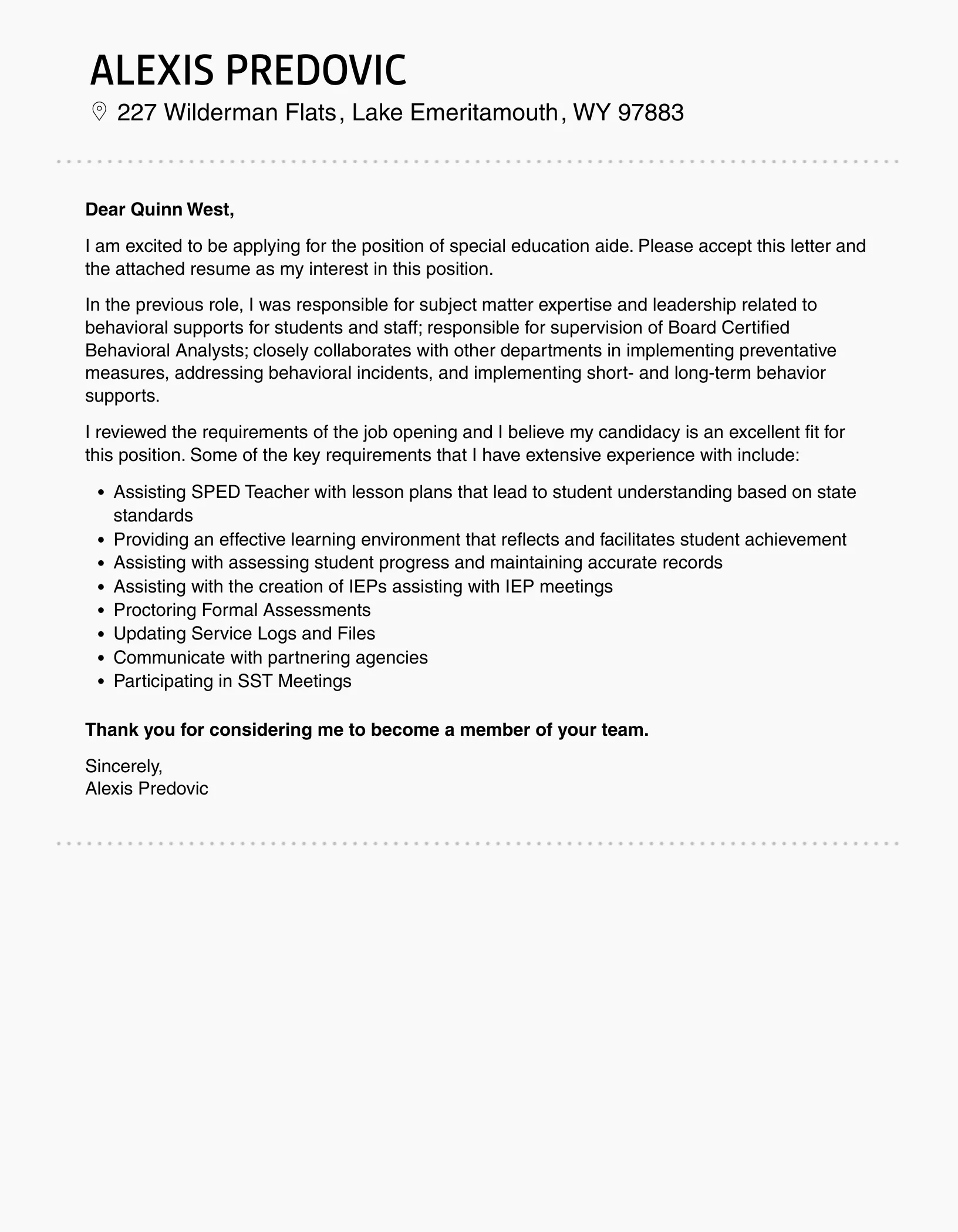
Proofreading and editing are critical steps in ensuring your cover letter is polished and professional. Carefully review your letter for any grammatical errors, typos, and inconsistencies in formatting. Use a grammar checker tool and have a friend or family member review your letter for an additional perspective. Pay close attention to your word choice, ensuring your language is clear, concise, and professional. Make sure that you have used the correct names and addresses throughout the letter. Ensure that the letter is free from any slang or colloquialisms. A perfectly proofread cover letter reflects your attention to detail and dedication to presenting yourself in the best possible light. It demonstrates respect for the hiring manager and shows that you take your application seriously.
Tailoring Your Cover Letter to the Job Description
Tailoring your cover letter to each specific job description is a crucial step in the application process. Generic cover letters are easily identifiable and can make you seem uninterested or inattentive. Carefully review the job description and identify the key requirements, skills, and qualifications the employer is seeking. Customize your cover letter to match these requirements, highlighting your relevant experience and skills. Use the same keywords and phrases that the employer uses in the job description to showcase how you meet their needs. Show, don’t just tell, by providing specific examples of your past accomplishments and how they align with the job’s expectations. Personalizing the cover letter will demonstrate that you have taken the time to understand the position and are truly interested in the role, significantly increasing your chances of getting selected for an interview.
Researching the School or District
Researching the school or district is a key part of tailoring your cover letter. Demonstrate your interest and initiative by familiarizing yourself with the school’s mission, values, and programs. Visit the school’s website, review their social media pages, and, if possible, speak with current or former employees. Find out about the school’s special education programs, student demographics, and any specific initiatives related to inclusion or support services. Reference these details in your cover letter, showing your understanding of the school’s culture and goals. This shows that you are genuinely interested in the opportunity and aligned with the school’s values, setting you apart from other candidates.
Matching Skills to Requirements
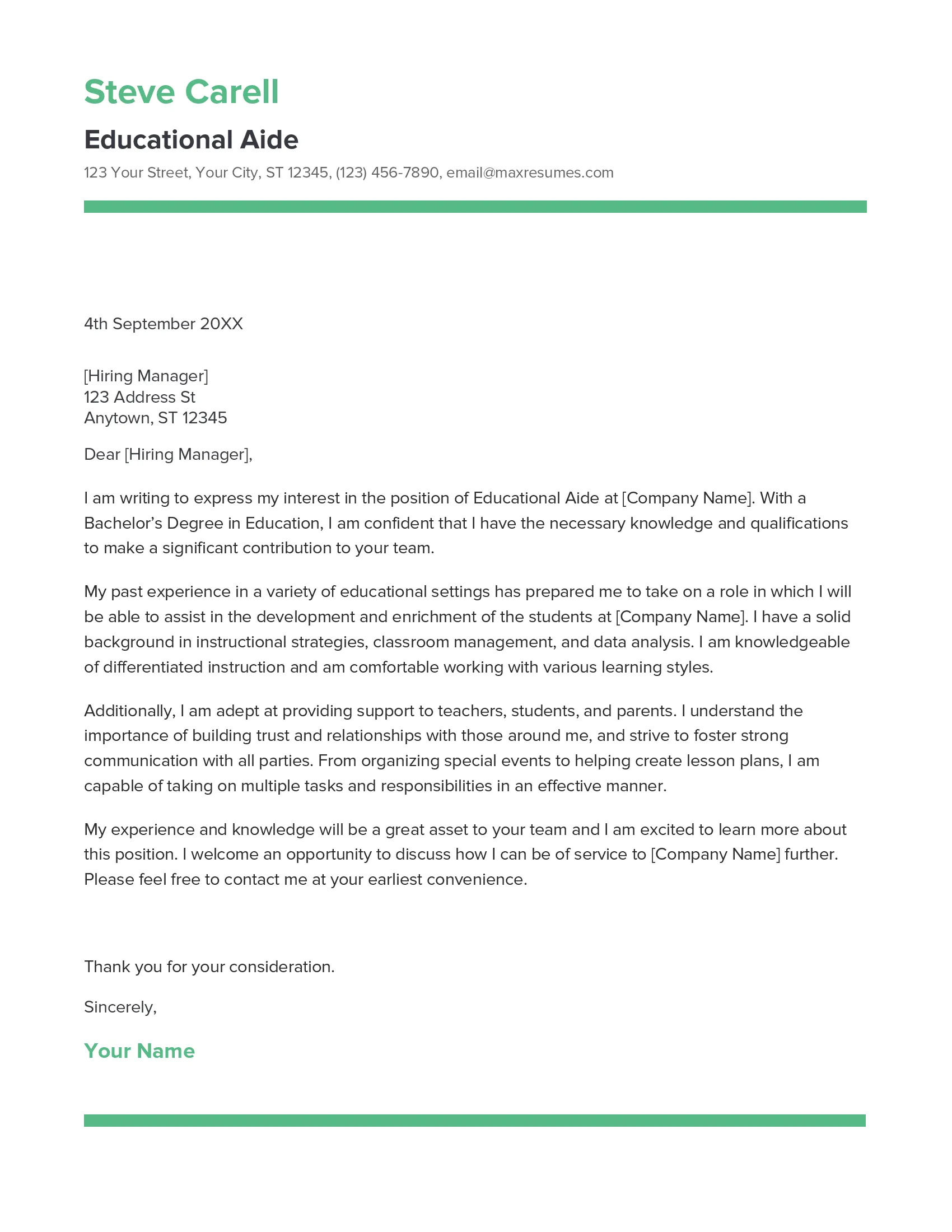
Carefully match your skills and experience to the specific requirements outlined in the job description. Identify the essential skills, qualifications, and experiences that the employer is seeking, and ensure that your cover letter highlights those aspects. Use the job description as a guide when organizing your letter, addressing the key requirements in separate paragraphs. Provide specific examples of how you have demonstrated these skills in your past roles. For example, if the job description requires experience with assistive technology, describe your proficiency in using specific software or devices. If the job involves collaboration with teachers and parents, highlight your experience in building positive relationships. Tailoring your skills and experience directly to the job description will prove that you are a strong fit for the role, and make it easy for the hiring manager to see that you meet their needs.
Using Keywords Effectively
Using relevant keywords from the job description is an effective strategy. Identify the key terms and phrases used in the job posting and incorporate them naturally into your cover letter. These keywords may include specific skills, technologies, or areas of expertise. Integrating keywords helps demonstrate that you understand the job requirements and match the employer’s needs. However, avoid keyword stuffing, which can make your letter sound unnatural and detract from your message. Use keywords strategically and only when they accurately reflect your skills and experience. Make sure that your language flows naturally and your focus remains on highlighting your qualifications and experiences. This balance of strategic keyword use with a well-written narrative will improve the readability and effectiveness of your cover letter, increasing your chances of securing an interview.
Common Mistakes to Avoid
Avoiding common mistakes is vital to create a strong impression. Reviewing for these errors can save you from getting passed over. These mistakes can undermine your credibility and reduce your chances of getting an interview. By paying attention to these details, you can significantly improve the impact of your cover letter.
Generic Cover Letters
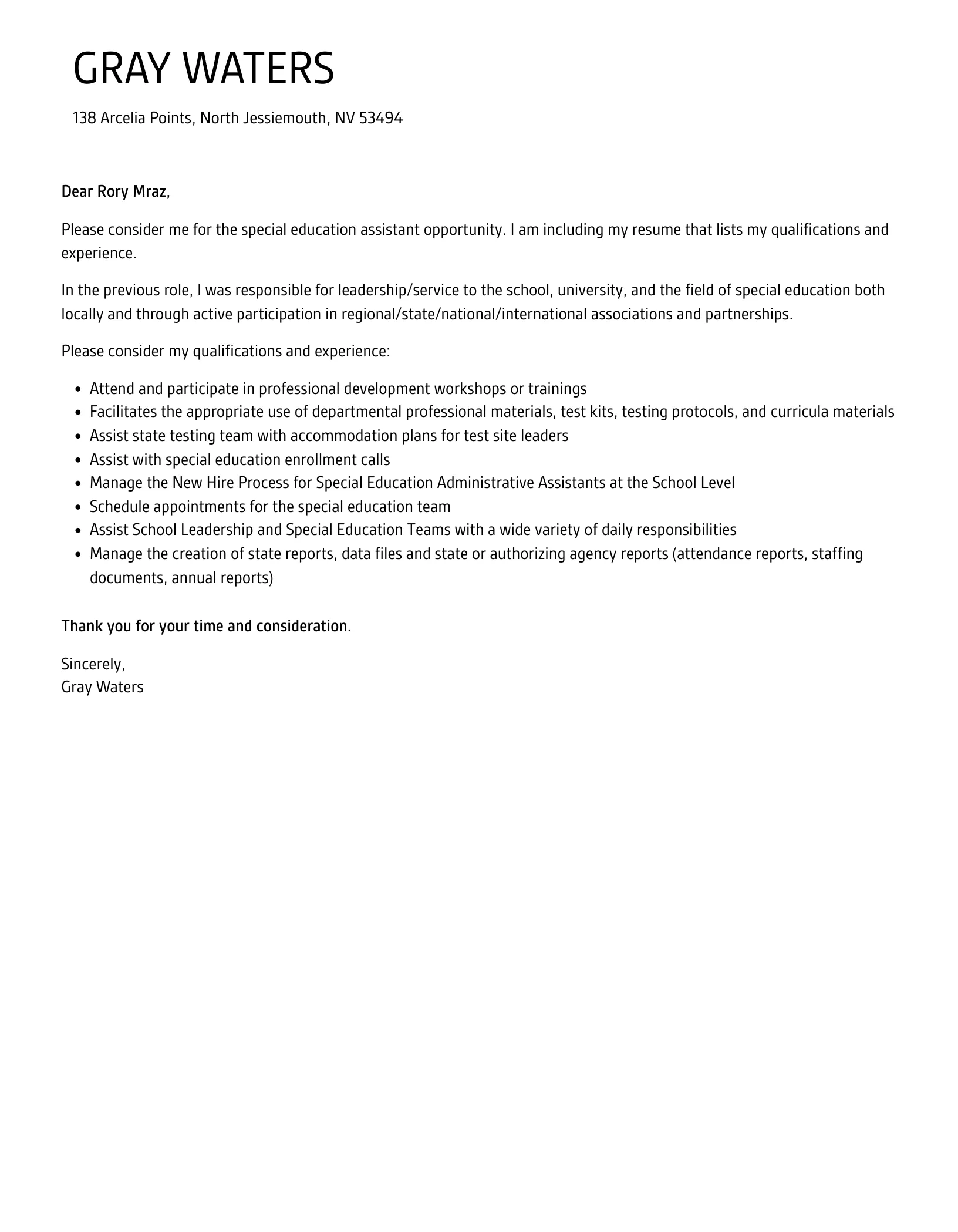
Avoid using generic cover letters that are not tailored to the specific job. A generic letter shows a lack of interest in the position and can make it appear that you are sending out mass applications. Tailor your cover letter to each specific job, highlighting your skills and experiences that directly relate to the requirements. Research the school or district, and reference specific aspects of their mission, values, or programs to show that you have taken the time to understand the opportunity. Personalizing your cover letter demonstrates genuine interest and significantly increases your chances of getting selected for an interview.
Typos and Grammatical Errors
Typos and grammatical errors can quickly create a negative impression and undermine your credibility. Always proofread your cover letter carefully, using a grammar checker tool and having a friend or family member review it for an additional perspective. Pay attention to your spelling, punctuation, and grammar. Typos can make you look unprofessional and can suggest a lack of attention to detail. Double-check the names and titles, and make sure your language is clear, concise, and error-free. A well-proofread cover letter demonstrates your commitment to excellence and gives the impression that you are serious about the opportunity.
Lack of Enthusiasm
Expressing enthusiasm is key to securing a job. Avoid writing a cover letter that lacks personality or passion. Show your enthusiasm for the position and the school by expressing your genuine interest in the opportunity. Highlight your excitement for working with students with special needs and demonstrate your commitment to their success. Use positive and energetic language, and let your passion shine through. Demonstrate your knowledge of the school and your understanding of the role to further show your interest. Conveying enthusiasm will help your letter stand out and make you appear more appealing to employers looking for dedicated team members.
Resources and Further Reading
To enhance your cover letter writing skills, utilize available resources and further reading materials. Many online resources, such as career advice websites and blogs, provide templates, examples, and guidelines for writing effective cover letters. Consult these resources to learn about formatting, language, and best practices for highlighting your skills and experience. Consider using cover letter builders to create a professional-looking cover letter quickly. Search for articles and guides specific to Special Education Aide cover letters to learn about the specific requirements and expectations for the role. Engaging with these resources can boost your confidence, improve your writing skills, and provide valuable insights into what employers are looking for.
Special Education Aide Cover Letter Templates
Cover letter templates can provide a useful framework for your application. Several templates specifically designed for Special Education Aides are available online. These templates offer pre-written sections and guidance on how to highlight your skills and experience. While templates provide a helpful starting point, remember to personalize them to match your qualifications and the specific job requirements. Fill in the template with your information, tailor it to the job description, and customize the content to reflect your unique experiences. Never submit a template without making these changes, as a generic template is a common mistake that can hurt your chances. Using a well-designed template as a foundation can help you create a professional and well-organized cover letter that highlights your skills.
Online Cover Letter Builders
Online cover letter builders offer a convenient way to create a professional-looking cover letter quickly. These tools typically provide a step-by-step process, guiding you through the different sections of your letter and offering suggestions for content. Some builders allow you to import your resume information directly, making the process even easier. These tools can be a helpful resource, especially if you are unfamiliar with cover letter formatting. Be sure to review the letter generated by the builder, personalize it, and make it your own to ensure it reflects your qualifications and experiences accurately. Always proofread the letter thoroughly and tailor it to the specific job requirements. Online cover letter builders can simplify the process and help you create a compelling application, giving you more time to focus on other aspects of your job search.
